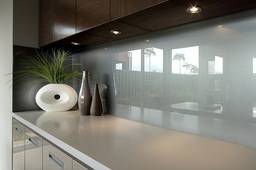Splashbacks

Kitchen Splash Backs
Choosing the right kitchen splashback involves considering various factors such as aesthetics, functionality, maintenance, and budget. Here's a guide to help you select the correct kitchen splashback:
1. Material:
-
Tiles: Ceramic, porcelain, glass, or natural stone tiles offer versatility in terms of colors, patterns, and textures. They are durable and relatively easy to clean but may require more maintenance, especially with grout lines.
-
Glass: Glass splashbacks provide a sleek, modern look and are easy to clean. They are available in a wide range of colors and can be customized to fit your kitchen's design.
-
Stainless Steel: Stainless steel splashbacks are durable, heat-resistant, and easy to clean. They are commonly used in commercial kitchens but can also add a contemporary look to residential kitchens.
-
Acrylic or Perspex: Acrylic or Perspex splashbacks are lightweight, affordable, and available in a variety of colors and finishes. They are easy to install but may scratch more easily than other materials.
-
Natural Stone: Granite, marble, or quartz splashbacks offer a luxurious look and are highly durable. However, they may require sealing to prevent staining and are typically more expensive.
-
Laminate: Laminate splashbacks are cost-effective and available in a wide range of colors and patterns. They are easy to clean but may not be as durable as other materials.
2. Style and Design:
-
Color: Choose a splashback color that complements your kitchen's color scheme and overall design aesthetic. Consider whether you want the splashback to blend in seamlessly or make a bold statement.
-
Pattern and Texture: Decide whether you prefer a plain, uniform surface or a textured or patterned design. Textured or patterned splashbacks can add visual interest and personality to your kitchen.
-
Size and Layout: Consider the size and layout of your kitchen when choosing the splashback. Larger kitchens may benefit from full-height splashbacks, while smaller kitchens may opt for a more minimalistic approach.
3. Practical Considerations:
-
Maintenance: Choose a splashback material that is easy to clean and maintain, especially in areas prone to splashes and stains. Avoid materials that require frequent sealing or special cleaning products.
-
Durability: Consider the durability of the splashback material, especially in high-traffic areas of the kitchen. Choose a material that can withstand heat, moisture, and everyday wear and tear.
-
Installation: Factor in the installation process and cost when choosing a splashback material. Some materials may require professional installation, while others can be DIY-friendly.
-
Budget: Set a budget for your kitchen splashback project and choose a material that fits within your budget constraints. Keep in mind that higher-end materials may cost more upfront but offer long-term durability and aesthetic appeal.
By considering these factors, you can choose the correct kitchen splashback that enhances your kitchen's aesthetic appeal, functionality, and practicality.
